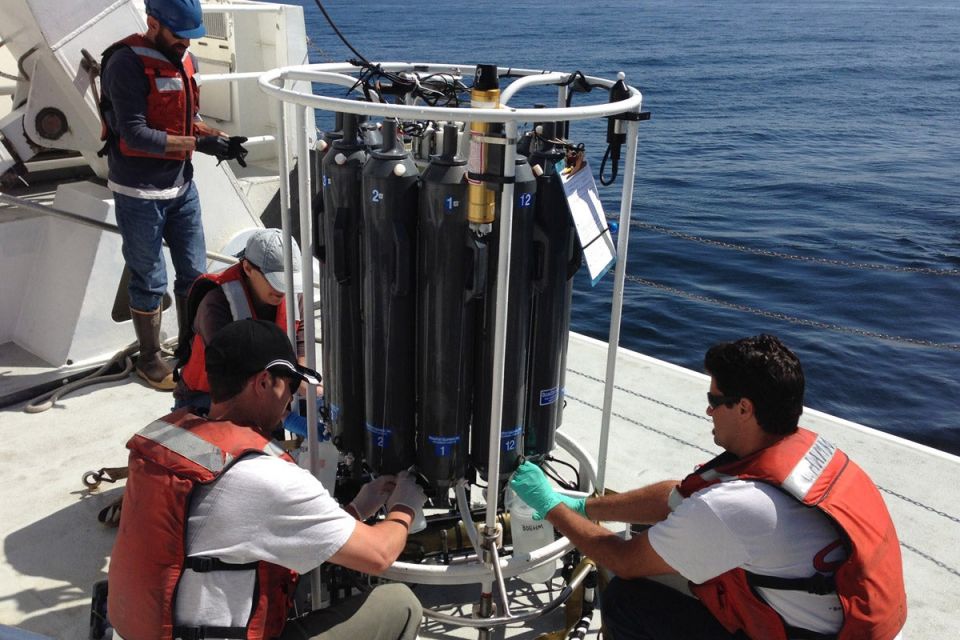The ocean might as well be Mars. Like astronomers grasping at ways to identify life on a distant planet, marine scientists have no easy method for detecting sea creatures’ presence in the vast watery realm.

Team members from the Monterey Bay Aquarium Research Institute collect water from Monterey Bay for eDNA analysis. (Image credit: Collin Closek)
An emerging technique – analyzing DNA in skin, scales and feces animals leave behind – has shown promise for revealing hidden ecosystems on land and in fresh water. But deep ocean environments have largely proven too complex for the approach. Now, Stanford scientists show progress in using this analysis to overcome complicated water movements and other obstacles to detect ocean animals in locations where the water can be more than 7,200 feet deep.
“We want to know what’s out there,” said study lead author Elizabeth A. Andruszkiewicz, a graduate student in Stanford’s Department of Civil and Environmental Engineering. “Eventually, this technology may answer bigger questions, such as how communities of organisms have adapted to environmental changes over time.”
Of the few previous environmental DNA, or eDNA, studies of ocean animals, all were done in relatively shallow nearshore environments. Most were done in controlled systems such as saltwater tanks, and few looked in real environments at questions of spatial distribution of eDNA.
The Stanford-led study also marks the first time the approach has been used in the deep waters of Monterey Bay, an important ecosystem in the California Current, which flows southward along the western coast of North America. In addition to being highly productive ecosystems, these areas have been the focus of relatively intensive ongoing research by institutions such as the Monterey Bay Aquarium Research Institute (a partner in the study). The resulting archived water samples and long-term datasets present unique opportunities for eDNA analysis of ecological change over time.
Collecting eDNA is fairly straightforward – a basic water sample does the trick – and scientists can archive these samples for long periods by freezing them. The approach promises a faster, more comprehensive and less invasive way to measure abundance and distribution of organisms. It might also be able to detect invasive species or changes in the distribution of endangered species.
“This could revolutionize the way we keep track of animals,” said study co-author Alexandria Boehm, professor of civil and environmental engineering and a senior fellow at the Stanford Woods Institute for the Environment.
Who goes there?
The eDNA survey identified 72 species of vertebrates (marine fishes, mammals such as elephant seals, humpback whales, sharks and rockfishes) at study sites across 28 miles of the Monterey Bay National Marine Sanctuary.
Scientists found DNA of some creatures, such as sunfishes, salmon, seahorses and mackerel sharks, only in locations where the water was less than 600 feet deep. DNA of other animals, such as dolphins and marine smelts, turned up only in waters more than 600 feet deep. The shallowest waters held the greatest biodiversity. Taken as a whole, the findings provide a proof of concept for eDNA as an ocean sleuthing tool.
“It is a remarkably powerful way to answer a simple question: What species are present in space and time in our oceans?” said co-author Barbara Block, the Charles and Elizabeth Prothro Professor in Marine Sciences at Stanford. “It could change how we view our planet’s marine biodiversity.”
Power of DNA
DNA sequencing has driven unprecedented research and discovery in fields ranging from medical diagnosis to evolutionary biology.

Pacific white-sided dolphins accompany the NOAA ship Reuben Lasker off the coast of California in June 2016 during a cruise collecting water samples for environmental DNA (eDNA) analysis. (Image credit: Collin Closek)
Preliminary studies have shown that eDNA sequencing can identify vertebrate species missed by traditional monitoring methods and can allow sampling in places inaccessible to traditional techniques such as dive surveys and fish trawls. The approach can also be used at finer resolutions, in terms of time and space, compared to traditional biomonitoring methods. This allows scientists to document changes in biodiversity over seasonal and annual cycles, as well as over different topographies.
Questions still remain about how to properly sample water for eDNA, and how to interpret sequencing results to avoid false positives and false negatives. Solving these and other challenges will bring into focus the next frontier for eDNA: counting actual numbers of sea animals and discerning their population-level identity, rather than just detecting their presence. Working with a team of geneticists, fish physiologists, oceanographers and engineers, Boehm and Block hope to realize that goal within 10 years.
Additional authors on “Biomonitoring of marine vertebrates in Monterey Bay using eDNA metabarcoding,” published in PLOS ONE, are Lauren M. Sassoubre, a former postdoctoral scholar at Stanford; Hilary A. Starks of Stanford’s Center for Ocean Solutions; and Francisco P. Chavez of the Monterey Bay Aquarium Research Institute.
The research was supported by a gift from the Seaver Institute to the Stanford Woods Institute for the Environment’s Environmental Venture Projects program, the U.S. Environmental Protection Agency and the David and Lucile Packard Foundation.
Media Contacts
Elizabeth Andruszkiewicz, Civil and Environmental Engineering: (860) 324-5620, eandrusz@stanford.edu
Alexandria Boehm, Civil and Environmental Engineering: (650) 724-9128, aboehm@stanford.edu
Barbara Block, Hopkins Marine Station: (650) 655-6236, bblock@stanford.edu
Rob Jordan, Stanford Woods Institute for the Environment: (650) 721-1881, rjordan@stanford.edu
